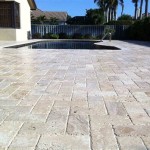Do You Need To Seal A Concrete Patio? Understanding the Benefits and Drawbacks
Concrete patios offer a durable and versatile outdoor living space. However, a common question among homeowners is whether sealing a concrete patio is necessary. The decision to seal a concrete patio involves weighing the potential benefits against the associated costs and effort. This article explores the advantages and disadvantages of sealing concrete patios, helping to determine the best course of action for specific needs and circumstances.
Sealing concrete refers to the application of a protective coating, typically a liquid polymer, to the surface. This coating penetrates the concrete pores, creating a barrier against water, chemicals, and other environmental factors. The type of sealer used can vary based on the desired finish, the level of protection needed, and the particular conditions the patio will face. Understanding these factors is crucial for making an informed decision regarding whether or not to seal a concrete patio.
Increased Protection Against the Elements
One of the primary benefits of sealing a concrete patio is the increased protection it provides against the elements. Concrete, while durable, is porous and can absorb water. Repeated freeze-thaw cycles, particularly in colder climates, can cause the absorbed water to expand and contract, leading to cracks and surface deterioration. This process, known as spalling, weakens the concrete over time and reduces its lifespan.
A sealer effectively minimizes water absorption. By creating a barrier, it prevents water from penetrating the concrete's pores. This reduces the risk of freeze-thaw damage and extends the life of the patio. In regions with heavy rainfall or snowfall, this protection is particularly valuable.
Moreover, sealing protects the concrete from chemical damage. De-icing salts, commonly used in winter, can corrode concrete. The sealer prevents these salts from reaching the concrete's surface and causing harm. Similarly, spills of oil, grease, or other chemicals can stain and degrade unsealed concrete. A sealer provides a layer of defense against these potentially damaging substances.
Furthermore, exposure to ultraviolet (UV) light can also degrade the surface of concrete over time, causing it to fade or become brittle. Some sealers contain UV inhibitors that help to mitigate this damage, preserving the patio's appearance and structural integrity.
Enhanced Appearance and Ease of Maintenance
Beyond protection, sealing a concrete patio can significantly enhance its appearance. Sealers are available in a variety of finishes, ranging from matte to glossy. A glossy sealer can give the patio a richer, more vibrant look, while a matte sealer provides a more subtle, natural appearance. The choice of finish depends on individual preferences and the overall aesthetic of the outdoor space.
In addition to the aesthetic benefits, sealing simplifies maintenance. Unsealed concrete is susceptible to staining from dirt, leaves, and other debris. Because its pores are open, these materials can penetrate the concrete's surface, making them difficult to remove. A sealed patio, on the other hand, is much easier to clean. The sealer creates a smooth, non-porous surface that prevents stains from setting in. Regular sweeping and occasional washing with a garden hose are often sufficient to keep a sealed patio looking its best.
Moreover, sealers can enhance the color of stamped or decorative concrete. They can bring out the subtle hues and patterns, making the patio more visually appealing. For plain concrete, some sealers are available with tints that can add color or enhance the existing shade. This allows homeowners to customize the look of their patios and create a more personalized outdoor space.
The ease of maintenance associated with a sealed patio can save time and effort in the long run. Less time spent cleaning means more time to enjoy the outdoor space. This can be particularly beneficial for homeowners with busy lifestyles or those who prefer low-maintenance landscaping.
Potential Drawbacks and Considerations
While sealing a concrete patio offers numerous benefits, it's important to consider the potential drawbacks and considerations. One key factor is the cost. Sealers, application tools, and potentially professional labor can represent a significant investment. The cost will vary depending on the type of sealer used, the size of the patio, and whether the work is done DIY or by a professional.
Another consideration is the maintenance required for the sealer itself. Sealers are not permanent and will wear down over time, especially with heavy use and exposure to the elements. Depending on the type of sealer used, it may need to be reapplied every one to three years to maintain its protective and aesthetic qualities. This reapplication requires cleaning the patio and applying a fresh coat of sealer, which can be time-consuming and require additional expense.
Furthermore, the application process can be tricky. Proper surface preparation is crucial for ensuring that the sealer adheres properly and provides long-lasting protection. This typically involves cleaning the patio thoroughly to remove dirt, debris, and any existing coatings. Any cracks or imperfections in the concrete should be repaired before sealing. If the surface is not properly prepared, the sealer may not adhere properly, leading to peeling, bubbling, or other problems.
Finally, some sealers can alter the slip resistance of the concrete. A high-gloss sealer, for example, can make the patio surface slippery, especially when wet. This can pose a safety hazard, particularly for children or elderly individuals. When selecting a sealer, it's important to consider the slip resistance and choose a product that provides adequate traction. Alternatively, anti-slip additives can be mixed into the sealer to improve traction.
Choosing the right type of sealer for your specific needs is essential. There are two main categories of sealers: penetrating sealers and film-forming sealers. Penetrating sealers soak into the concrete and provide protection from within, while film-forming sealers create a protective layer on the surface. Each type has its own advantages and disadvantages, and the best choice will depend on the desired level of protection, the aesthetic preferences, and the specific conditions of the patio.
Penetrating sealers, such as silanes and siloxanes, are known for their ability to repel water without significantly altering the appearance of the concrete. They are also breathable, which means they allow moisture vapor to escape from the concrete, preventing blistering and peeling. However, they may not provide as much protection against stains and chemicals as film-forming sealers.
Film-forming sealers, such as acrylics and epoxies, create a durable, protective layer on the surface of the concrete. They offer excellent protection against stains, chemicals, and abrasion. They are also available in a variety of finishes, from matte to glossy. However, they can be less breathable than penetrating sealers, and they may be more prone to peeling or chipping if not applied properly.
Ultimately, the decision of whether or not to seal a concrete patio is a personal one that depends on individual circumstances and priorities. Weighing the benefits of increased protection, enhanced appearance, and ease of maintenance against the costs, effort, and potential drawbacks can help to make an informed decision.
Consider the climate in which you live. In regions with harsh winters or frequent rainfall, sealing may be a worthwhile investment to protect the patio from freeze-thaw damage and water damage. Consider the amount of traffic the patio receives. A patio that is used frequently for entertaining or outdoor dining may benefit from the added protection against stains and spills that a sealer provides.
Evaluate your budget and willingness to perform maintenance. Sealing a patio involves upfront costs and ongoing maintenance, so it's important to factor these costs into your decision. If you are not comfortable with DIY projects, you may need to hire a professional, which will add to the overall expense. By carefully considering these factors, you can determine whether sealing a concrete patio is the right choice for your needs.

Why You Should Seal Your Concrete Driveway Or Patio Gleam Team
Why You Should Seal Your Concrete Driveway Or Patio Gleam Team

Pros And Cons Of Sealing Concrete Patios

Wet Look Concrete Sealer What You Need To Know

Sealing A Concrete Patio What S The Best Sealer Network

Professional Concrete Sealing Types Methods In Wichita

How Often Should You Reseal Your Concrete Increte Of Houston

How To Seal Concrete The Right Way Project Summary Bob Vila

Do I Need To Seal Outdoor Concrete Barefoot

Beautify And Protect Your Patio
Related Posts








